| کد مقاله | کد نشریه | سال انتشار | مقاله انگلیسی | نسخه تمام متن |
|---|---|---|---|---|
| 1743177 | 1522003 | 2013 | 13 صفحه PDF | دانلود رایگان |

Understanding potential impacts of CO2 leakage on groundwater quality in shallow aquifers is a critical concern for geologic sequestration. This study presents a single-well push–pull test conducted in the Cranfield shallow aquifer, the SECARB Phase III early test site, for assessing potential impacts of CO2 leakage on groundwater quality. Groundwater pH, alkalinity, and electric conductivity were measured on site, and water samples were collected for chemical concentrations (major ions, trace elements, and dissolved inorganic carbon—DIC) and DIC stable carbon isotope analyses. Bromine (Br) tracer was used as an indicator of mixing of background water with the injected solution. The data gained from these measurements was then used to develop a mixing model to provide a quantitative analysis of the mobilization of major ions and trace metals from the aquifer sediments to groundwater as a result of the injection of CO2-enriched groundwater.Major ions, especially calcium (Ca), magnesium (Mg), potassium (K), and silicon (Si), show obvious enrichment, indicating mobilization of these ions from aquifer sediments to groundwater that may be dominated by dissolution of silicates and possibly carbonate minerals. Stable carbon isotope (δ13C) of DIC of the recovered samples also suggests potential dissolution of carbonates. Whereas concentrations of trace elements were elevated after injection of CO2-enriched groundwater, their maximum concentrations remained below the EPA's maximum contamination levels (MCLs). Mobilization of trace elements could be due to dissolution of silicates and carbonates and desorption from a clay surface. Mass-balance calculations suggest that ion mobilization is limited, and, therefore, potential risks of CO2 are low, especially for arsenic and lead, which appeared in the recovered samples at concentrations of approximately 3% of the EPA MCL. Overall reaction rates estimated from the push–pull test were generally smaller than overall reaction rates in a batch experiment. Results of the push–pull test suggest that groundwater pH, DIC, and δ13C of DIC may be helpful in detecting CO2 leakage signals. Our study indicated that single-well push–pull tests can be a valuable approach for assessing potential impacts of CO2 leakage on drinking water resources at geological CO2 sequestration sites.
► A single well push–pull test was conducted in the Cranfield shallow aquifer.
► A mixing model was used to evaluate ion mobilizations from sediments to groundwater.
► Overall reaction rates in the push–pull test are generally smaller than in a batch experiment.
► Risks of CO2 leakage on groundwater quality in the carbonate-poor aquifer are low.
► Groundwater pH, DIC, and δ13C of DIC may be useful for detecting CO2 leakage.
Journal: International Journal of Greenhouse Gas Control - Volume 18, October 2013, Pages 375–387